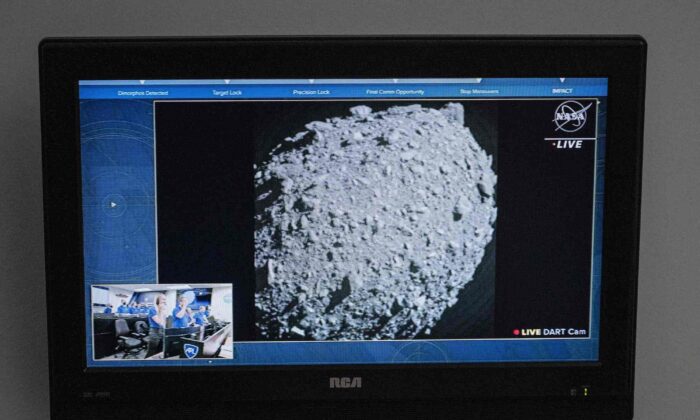
A television at NASA’s Kennedy Space Center in Cape Canaveral, Florida, captures the final images from the Double Asteroid Redirection Test (DART) just before it smashes into the asteroid Dimorphos, on Sept. 26, 2022. (Jim Watson/AFP via Getty Images)
By
NASA’s asteroid-deflecting DART spacecraft successfully struck a football stadium-sized asteroid in a historic test of the world’s first planetary defense system, designed to prevent a cosmic doomsday collision with Earth.
“IMPACT SUCCESS!” NASA declared on Twitter after the spacecraft, flying at 14,000 miles per hour, struck “Dimorphos” on Monday at 7:14 p.m. ET.
The U.S. space agency live-streamed the spacecraft’s progress and ultimate impact, allowing a global audience to watch via the DART Mission’s DRACO camera as the vending machine-sized spacecraft collided with the football stadium-sized asteroid Dimorphos.
The asteroid, currently around 6.8 million miles away, poses no threat to Earth, according to NASA.
The DART Mission helps determine how this method could be used in a real-life planetary defense situation, as even a small change to an asteroid’s trajectory could be enough to avert a doomsday impact, provided the space rock is far enough away.
Double Asteroid Redirection Test
The DART Mission, or Double Asteroid Redirection Test, was designed to see if slamming a spacecraft into an asteroid would change its speed and path in space through kinetic impact.
NASA chose to target the approximately 530-foot-size Dimorphos asteroid, which orbits a larger, 2,560-foot asteroid known as Didymos, which together form a binary, near-Earth asteroid system.
DART’s impact on Dimorphos is expected to change its orbit within the binary system, with the goal to shorten the smaller asteroid’s nearly 12-hour obit around the larger asteroid by several minutes.
The DART Investigation Team will study the actual results of the test over the next several weeks and compare them to “highly detailed computer simulations” of kinetic impacts on asteroids.
The $325 million mission will help determine the effectiveness of DART’s kinetic impact, or “nudging,” approach to planetary defense.
The DART spacecraft was launched in November 2021 and took 10 months to fly to its space rock target.
The Italian Space Agency’s LICIACube, which deployed from the DART spacecraft, will now fly past Dimorphos about three minutes after DART impacts.
LICIACube is programmed to document the effects of the impact, taking images of the asteroid’s surface and any debris ejected from the newly formed crater with its two optical cameras.
“The CubeSat’s goals are to confirm the spacecraft impact, observe the evolution of the ejected plume, potentially capture images of the newly formed impact crater, and image the opposite hemisphere of Dimorphos that DART will never see,” according to a news release.
NASA will use telescopes on Earth to measure how much of an impact the DART mission had on the asteroid’s motion in space.